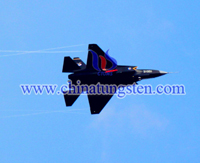Applications of 3D Printing Technique in Aviation Industry (II)
- Details
- Category: Tungsten Information
- Published on Friday, 07 June 2013 09:00
On May 29th 2013, there was an article in South China Morning Post of Hong Kong named as 3D Printer Promotes the Development of Chinese aircraft. For aircraft enthusiasts, it is not a dream that use computer and 3D printer to manufacture a small plastic aircraft. How about manufacturing a real aircraft?
The Chinese scientists and aeronautical engineer consider that can be realized. They have began to use 3D printer to manufacturer refractory metal aircraft parts without molding, forging, assembling or other traditional manufacturing processes.
3D printing, also called as laser rapid prototyping is a newly developing manufacturing technique. 3D printers can transform blueprint on computer into material object directly by overlying materials layer by layer until finished products.
Refractory metal aircraft parts, being manufactured by 3D printing technique have been widely used for C-919 the first Chinese civil aircraft, J-15 the first carrier fight, J-16 multipurpose fighter-bomber, J-20 the first Chinese stealth fighter and J-31 the fifth generation fighter.
Traditional aviation industry not only spends too much time, and it also wastes a lot of materials. In generally, only 10 percent of raw materials are utilized. The rest are lost during the processes of molding, forging, cutting and burnishing. F-22 fighter which developed by Lockheed Martin in the U.S. needs 2796kg titanium alloy. In fact, only 144kg is utilized.
Sidney Wong, the associate dean of Enterprise Development Department in Hong Kong Polytechnic University showed that 3D printing technique could accelerate the development of Chinese new generation aircraft. He said, “3D printing technique can save time and materials. Researchers can print refractory metal aircraft parts directly in a short time. The cost of prototype is low without molding or any other complicated traditional processes and scientists can manufacture constantly more repetitions for test.”
directly in a short time. The cost of prototype is low without molding or any other complicated traditional processes and scientists can manufacture constantly more repetitions for test.”
Professor Wang Huaming, the expert of aerial material in Beijing University of Aeronautics & Astronautics considered that Chinese 3D printing technique had exceeded the U.S. because the U.S. could only manufacture small products by using the technique. However, Luo Jun, the CEO of Asian Manufacturing Association in Beijing considered that the Chinese printing technique still fell behind the West.
Tungsten Manufacturer & Supplier: Chinatungsten Online - http://www.chinatungsten.com
Tel.: 86 592 5129696; Fax: 86 592 5129797
Email: sales@chinatungsten.com
Tungsten Picture Center: http://picture.chinatungsten.com
Tungsten Video Center: http://v.chinatungsten.com
Tungsten News & Tungsten Prices, 3G Version: http://3g.chinatungsten.com



 sales@chinatungsten.com
sales@chinatungsten.com